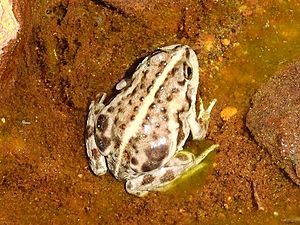Large four-eyed frog facts for kids
Quick facts for kids Large four-eyed frog |
|
|---|---|
 |
|
| Conservation status | |
| Scientific classification | |
| Synonyms | |
|
Pleurodema bufonina |
The Pleurodema bufoninum, also known as the large four-eyed frog, is a special type of frog. It belongs to a family of frogs called Leptodactylidae, which are mostly found in Central and South America. This frog lives in parts of Argentina and Chile.
This frog gets its interesting name, "four-eyed frog," from two special glands on its back. These glands look a lot like eyes! They are actually poison glands. When the frog feels scared or threatened, it has a clever trick. It lowers its head and lifts its rear end. This makes the "eye-like" poison glands point towards the danger. A predator might get confused, thinking the frog's rear is the head of a much bigger animal. This trick helps the frog stay safe from enemies.
Contents
Where Does the Large Four-Eyed Frog Live?
The large four-eyed frog lives in many different places. Its natural habitats include various types of forests and shrublands. You can find it in cool, damp subantarctic forests and temperate forests. It also lives in different kinds of shrublands, from subantarctic to subtropical dry areas.
Frog Habitats
These frogs also enjoy open grassy areas. They live in subantarctic and temperate grasslands. They are often found near water, like rivers that sometimes dry up, or swamps. They also like freshwater marshes that might not always have water. Sometimes, you can even spot them in places changed by humans, like farms, gardens, and even open holes in the ground. They especially like ponds where they can find water.
What Makes This Frog Special?
The large four-eyed frog is unique because of its clever defense system. Most frogs try to hide or jump away from danger. But this frog uses a different method. It uses its body to trick predators.
How the "Eyes" Work
The two "eyes" on its back are not real eyes. They are special glands that can release a mild poison. When the frog raises its rear, these glands become very noticeable. This posture, combined with the "eyes," can make a predator hesitate. The predator might think it's looking at a larger, more dangerous animal, or it might be warned by the sight of the "eyes" that the frog is not a good meal. This simple but effective trick helps the large four-eyed frog survive in its environment.
Who Discovered This Frog?
The large four-eyed frog was first described by a scientist named Thomas Bell. He was a British zoologist, which means he studied animals. He officially named and described this frog in the year 1843. Scientists give animals two names: a genus name and a species name. For this frog, the scientific name is Pleurodema bufoninum. This helps scientists all over the world know exactly which animal they are talking about.
See also
 In Spanish: Sapo de cuatro ojos grandes para niños
In Spanish: Sapo de cuatro ojos grandes para niños


